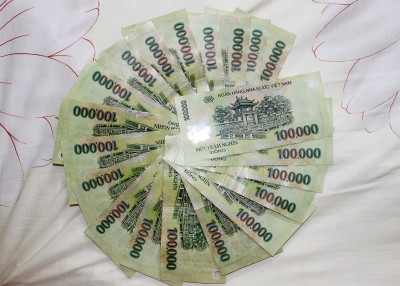This post is about how to save money when using money in Vietnam as a tourist. There are many ways to “import” money to Vietnam, some are cheaper and some are more expensive regarding fees and exchange rates. I did some research on the most common ways*.
The currency in Vietnam is Dong. In 2010 the exchange rates for Euro and US Dollar (USD) were around:
25.000 Dong = 1 Euro
20.000 Dong = 1 USD

In Vietnam you can often pay either in USD or in Dong. Sometimes prices are actually given in USD, especially at tourist agencies and hotels. If the price is in USD, then the cheapest way is to pay in USD, because the exchange rate to Dong is always to the advantage of the salesman. Therefore the best thing is to bring enough USD with you when you come to Vietnam.
The other reason why it is best to bring USD and also Euro to Vietnam is, because the exchange rate you get, when you exchange USD or Euro into Dong at a bank or an exchange booth, are really good. Sometimes they are even better than the rates at the foreign exchange market.
However, if you stay for a longer period of time you probably run out of USD at some point. Despite some rumors on the internet, it is not possible in Vietnam to withdraw US Dollar notes from the ATM or from banks. It is possible to exchange Dong into US Dollar at the exchange booths on the streets, but the exchange rates there are really bad.
In case you enter Vietnam from Cambodia, you should withdraw enough US Dollars at an Cambodian ATM before. Cambodian ATM’s only withdraw US Dollar and at the Canadia Bank ATMs there are no withdrawal fees.
The second cheapest way to get money in Vietnam (if you run out of Euro or USD), is to withdraw Dong from an ATM with a cash card*. The problem is, that the ATM’s of local banks in Vietnam have a very low withdrawal limit, which is between two and five million Dong. When staying in Vietnam for a longer period of time you would have to go to an ATM quite often, and each time withdrawing you would have to pay fees to your bank institute at home and to the Vietnamese bank (around 20.000 to 40.000 Dong).
However there are also ATM’s belonging to international banks, where the withdrawing limit is much higher. In Saigon I found the following international banks: Commonwealth Bank, Citibank, Deutsche Bank and ANZ Bank.
I was able to withdraw 9.000.000 Dong from a Commonwealth ATM in Saigon with no withdrawal fees. A friend of mine got 8.000.000 Dong out of a Citibank ATM and payed 20.000 Dong withdrawal fee. I heard at the ANZ ATM it is possible to get even more money.
International banks can easily be found in Saigon and Hanoi, however hardly in smaller towns. There are no international banks in Nha Trang and Mui Ne. So it would be better to withdraw enough money in advance in one of the big cities.
The last and most expensive paying option is to use a credit card. Many places in Vietnam except the most common credit cards like Visa or Master Card. However, often when you pay with credit card you will be charged additionally 3 percent from the price of your purchase by the salesman (this is in addition to any other fees you pay to the credit card company). This is especially the case for “cheaper” places. Normally, at more expensive hotels or restaurants there are no extra charges, and paying with credit card is still a good option (when paying in USD).
The absolute worst way of paying in Vietnam is to pay with credit card in Dong at a “cheap” shop when the price is given in USD. Then you will get an additional 3 percent charge for paying with credit card and a bad exchange rate into Dong.
Ultimately all the fees and hidden fees you pay to the banks when using money in a foreign country are very arcane and different in every case. So there is no point in going into to much detail here. It is interesting to note, however, that some of the fees are hidden in the exchange rates. In the following links you can find the latest exchange rates by Paylife (exchange rates used by Erste Bank) and Visa Card Complete: (paylife has better rates!)
http://www.paylife.at/web/content/de/Home/Service/Fremdwaehrungskurse/currencyList.jsp
http://www.cardcomplete.com/services/fremdwaehrungen/
* Some of the information given in this post don’t apply in general. They are only completely true for my Austrian bank institute, the Erste Bank, and my credit card company Visa, by Card Complete. For other companies and other countries the fees and exchange rates might be different.
Thanks for the info it was useful.